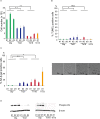Elimination of protein aggregates prevents premature senescence in human trisomy 21 fibroblasts
- PMID: 31356639
- PMCID: PMC6663065
- DOI: 10.1371/journal.pone.0219592
Elimination of protein aggregates prevents premature senescence in human trisomy 21 fibroblasts
Abstract
Chromosome abnormalities induces profound alterations in gene expression, leading to various disease phenotypes. Recent studies on yeast and mammalian cells have demonstrated that aneuploidy exerts detrimental effects on organismal growth and development, regardless of the karyotype, suggesting that aneuploidy-associated stress plays an important role in disease pathogenesis. However, whether and how this effect alters cellular homeostasis and long-term features of human disease are not fully understood. Here, we aimed to investigate cellular stress responses in human trisomy syndromes, using fibroblasts and induced pluripotent stem cells (iPSCs). Dermal fibroblasts derived from patients with trisomy 21, 18 and 13 showed a severe impairment of cell proliferation and enhanced premature senescence. These phenomena were accompanied by perturbation of protein homeostasis, leading to the accumulation of protein aggregates. We found that treatment with sodium 4-phenylbutyrate (4-PBA), a chemical chaperone, decreased the protein aggregates in trisomy fibroblasts. Notably, 4-PBA treatment successfully prevented the progression of premature senescence in secondary fibroblasts derived from trisomy 21 iPSCs. Our study reveals aneuploidy-associated stress as a potential therapeutic target for human trisomies, including Down syndrome.
Conflict of interest statement
The authors have read the journal's policy and have the following competing interests: This study received funding from Mitsui Life Social Welfare Foundation, and Shionogi & Co., Ltd. Dr. Mahito Nakanishi is the founder and chief technology officer (CTO) of Tokiwa-Bio, Inc. Method to generate iPS cells with SeVdp vector installing reprogramming genes is protected by following patents: JP 4936482; JP 5633075; JP 5963309; US 9145564; US 8496941 B2; US 9365866 B2; EP 2434012; EP 2639297. This does not alter our adherence to all the PLOS ONE policies on sharing data and materials.
Figures






References
Publication types
MeSH terms
Substances
LinkOut - more resources
Full Text Sources
Other Literature Sources
Molecular Biology Databases

